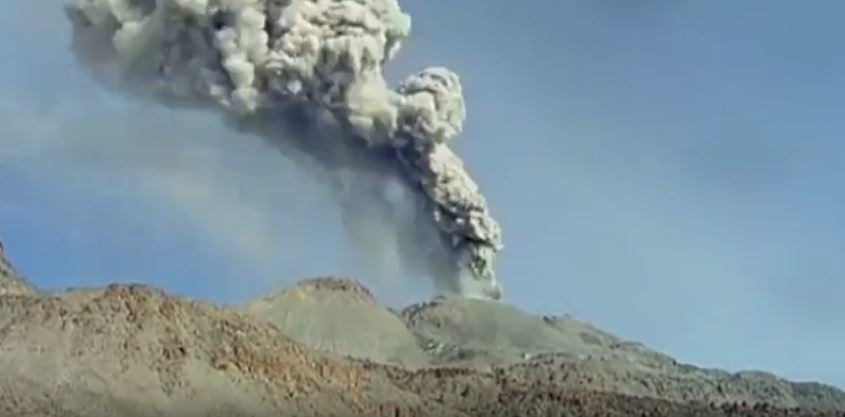
© YouTube/breaking news (screen capture)Peru's Sabancaya volcano erupts.
PerúSabancaya has been restless for the last two years, with periods of heightened activity and a return to quiet. However, it looks like the Peruvian volcano has entered a new phase of activity since early November. The volcano has produced dozens of explosive eruptions since
November 6, when the renewed activity began.
This first explosion generated an M3.6 earthquake as well. Ash has reached 1.5-3.5 kilometers (4,900-11,400 feet) over the volcano and
spread ash over 40 kilometers (25 miles) from the volcano on the people living across the area. The ash plumes (see below) have been some of the highest ever recorded at Sabancaya and
video from the explosions show a vigorous plume of dark grey ash from the volcano.
Interestingly, the number of earthquakes is down some from late September and early October, possibly betraying the time for the magma to rise from depth into the volcano to cause these explosions. Deformation of the volcano continues, which supports the idea that magma is still rising into the edifice and sulfur dioxide emissions remain high (almost 3,000 tonnes/day), so all signs still point to continued likelihood of explosive eruptions.
This continued threat means that a
state of emergency has been declared across 23 districts around Sabancaya due to this ash hazard for the next 60 days. This area is
a tourist destination, so any prolonged unrest at Sabancaya could impact that industry. The volcano remains on
Yellow alert status. You can see the changing activity at Sabancaya on the webcam pointed at the crater.
Sabancaya isn't the only restless volcano in Peru right now, either.
Ticsani has been
experiencing earthquakes over the past few months that all suggest magma is moving into the volcano. The number of earthquakes has dropped some at Ticsani since earlier in the year, but harmonic tremor, a sure sign of magma movement, has increased over the past few weeks. However, deformation and degassing is low, so an eruption isn't likely happening in the immediate future. The only known eruption of Ticsani was in ~1800 A.D.
Ubinás has also had an eventful 2016, with numerous explosions from Peru's most active volcano. Over the past few months,
the volcano has had a couple bouts of seismicity that quieted during much of October. However, since the start of November, there have been numerous earthquakes, tremor and some explosions that sent ash ~1.5 km (4,900 feet) over the volcano.
Those explosions coincided with a spike in sulfur dioxide emissions, all supporting the conclusions that new magma is rising into the volcano. You can check out the
IGP webcam or
INGEMMET webcam to see what's going on at the restless Andean volcano.
ChileFurther south,
an explosive eruption on November 17 occurred at
Nevados de Chillán that sent ash 1.2 kilometers (3,900 feet) over the volcano. This is one of a number of "ash puffs" that the volcano has produced over the last year, most of which were noticed thanks to the
webcam pointed at the volcano. Nevados de Chillán remains at
Yellow alert status.
Meanwhile,
M3.6 earthquake shook Hudson in southern Chile. The SERNAGEOMIN thinks the earthquake was related to fluid movement within the volcano, although it could be from hydrothermal activity rather than magma. The last eruption from
Hudson was in 2011 and the
1991 eruption was a VEI 5, one of the largest of the 20th century.
Reader Comments
to our Newsletter